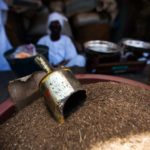
Toombak is a form of smokeless tobacco is widely used by the Sudanese population and many others in the sub-Sahara region but not well known in Western Society. Sudan has the second highest incidence for oral cancer in the Middle East but while the risks of smokeless tobacco are known the risks of oral leukoplakia and oral squamous cell carcinoma among toombak users are less well explored.
The aim of this review was to explore the association between the use of toombak and oral leukoplakia and oral squamous cell carcinoma (OSCC).
Methods
Searches were conducted in the Scopus, Embase, Web of Science, Google Scholar, ProQuest and OpenGrey databases. Clinical trials (randomized controlled trial) and/or observational studies (cross‐sectional, population‐based and case‐control) that assessed the associated risk of developing oral leukoplakia/OSCC among their patients who were using toombak published in English between 1990 to 2018 were considered. Two reviewers independently selected studies extracted data and assessed risk of bias using the Newcastle‐Ottawa scale (NOS).
Results
- 8 studies (5 cohorts, 2 case-control, 1 cross-sectional) all conducted in Sudan were included.
- NOS scores ranged from 4 to 8 with 3 studies scoring more than 7 and being rated good.
- 3 studies reported an associated risk of developing oral leukoplasia/OSCC among toombak users
- For toombak users compared with the controls: –
- 1 study reported an odds ratio (OR) = 7.3 (95%CI: 4.3‐12.4) for lip, buccal mucosa cancer and
- OR = 3.9 (95% CI: 2.9‐5.3) for the floor of the mouth cancer.
- 1 study reported an adjusted OR = 3 (95%CI 0.91‐9.7) for epithelial dysplasia among toombak dippers. A higher odds ratio (OR = 3.8, 95%CI: 1.7‐8.6) was reported after adjusting for confounding habits (alcohol and cigarette use) among exclusive toombak users.
- 3 studies reported the associated risk of toombak with respect to gender.
- A significant association between OSCC development and toombak use was seen in both males OR = 3.0 (95% = CI: 1.35‐6.7) and females OR = 15.2, (95% CI: 1.8‐6.1).
- The majority of studies reported the duration of toombak use, which ranged from 10 to 45 years.
- 1 study reported on frequency of toombak use per day which ranged from less than 10 to greater than 10 episodes of use per day.
- However, the frequency of toombak use per day was reported by only one study. It ranged from less than 10 to greater than 10 episodes of use per day.
- Increased risk of developing OSCC was reported among long‐term users of toombak and ranged from OR = 4.3 (95%CI: 2.9‐6.3) compared population controls and
- OR = 11.0 (95%CI: 4.8‐25.1) compared to hospital controls.
Conclusions
The authors concluded: –
In this study, we found a strong causal association between toombak users and oral leukoplakia and/or OSCC. The associated risk is highest among current toombak users compared with non ‐users. The associated risk increases with increased duration of toombak use. Given the strong, epidemiological evidence generated here, further large-scale multi‐centre prospective studies, together along with in‐vivo and in‐vitro studies should provide further insight into the potential role of toombak in oral carcinogenesis.
Comments
A broad search strategy has been used to identify papers for this review although given the specific regional use of toombak it is perhaps surprising that only English language papers have been included. All of the included studies are from the Sudan and several involve the same authors. Most of the studies were hospital based so may not represent the broader population in Sudan. No meta-analyses have been conducted and the results from individual studies are presented which should be taken into consideration when interpreting the findings. Although the magnitude of the odds ratios do indicated a strong association between toombak use and OSCC.
Links
Primary Paper
Patil S, Arakeri G, Alamir AWH, Patil S, Awan KH, Baeshen H, Raj T, Fonseca FP, Brennan PA. Is toombak a risk factor for oral leukoplakia and oral squamous cell carcinoma? A systematic review. J Oral Pathol Med. 2019 Aug 22. doi:10.1111/jop.12954. [Epub ahead of print] Review. PubMed PMID: 31436350.
Other references
Dental Elf – 14th Mar 2016
Tobacco use and alcohol intake key risk factors for head and neck cancer
Picture credits
“Chewing tobacco in Darfur” by UNAMID Photo is licensed under CC BY-NC-ND 2.0
